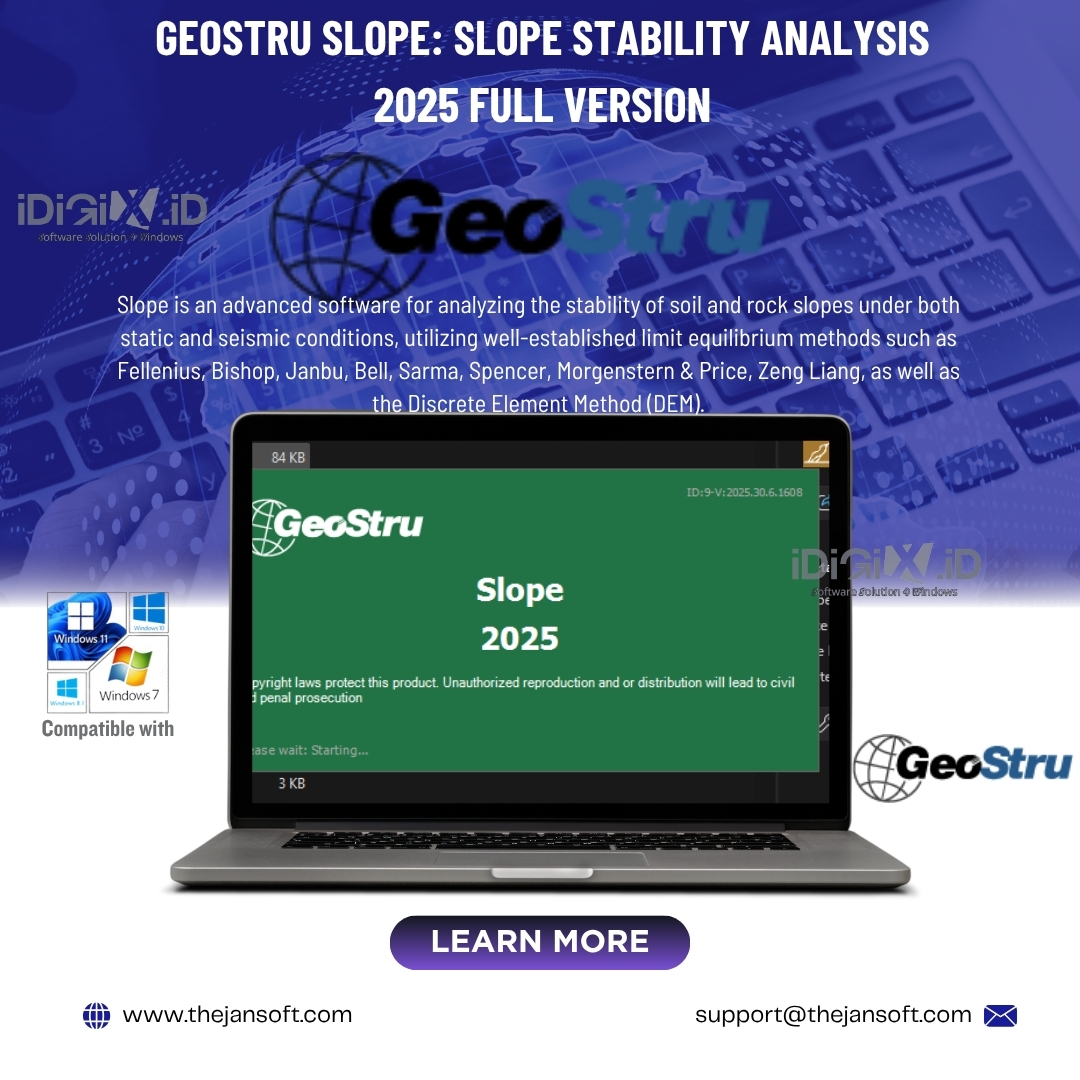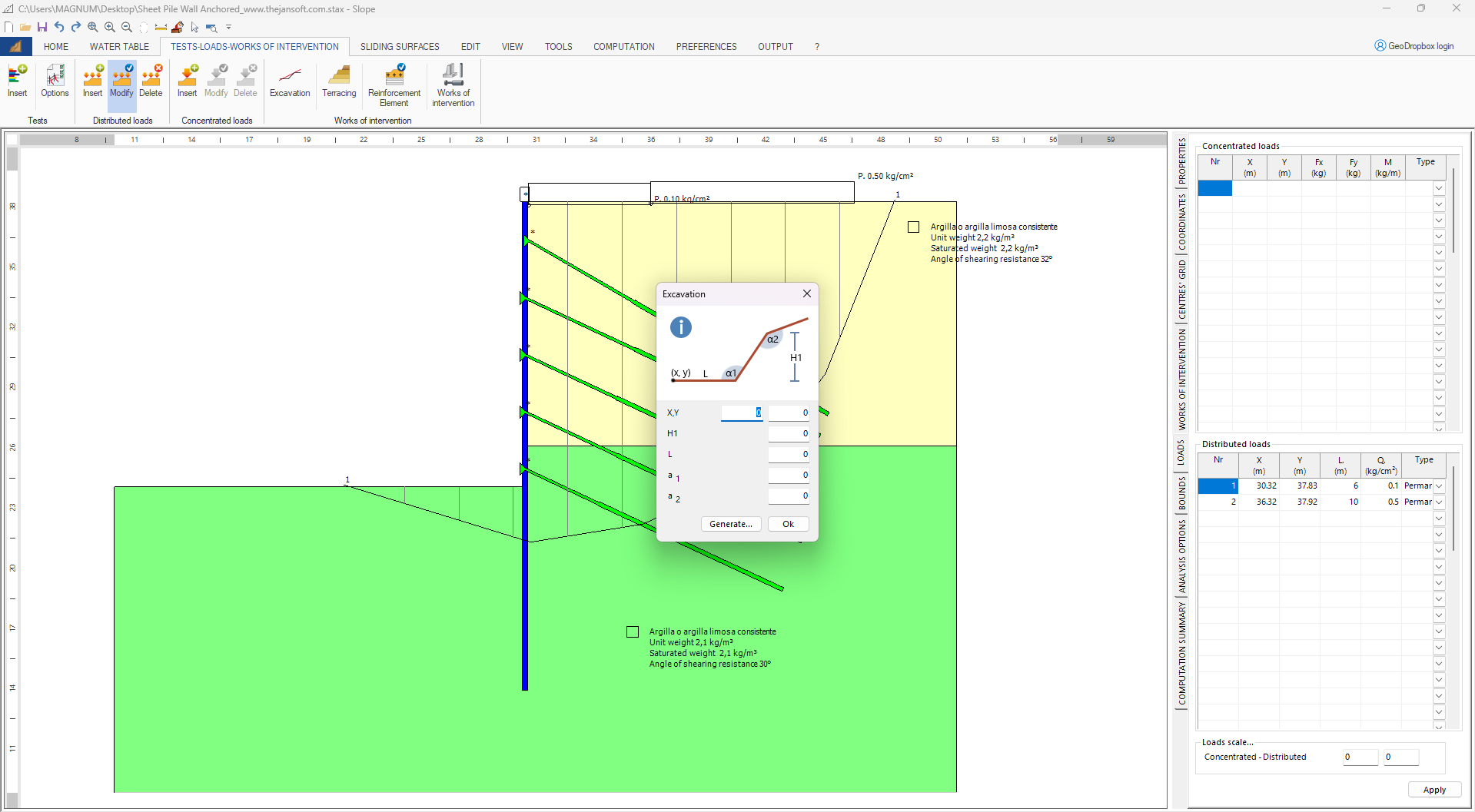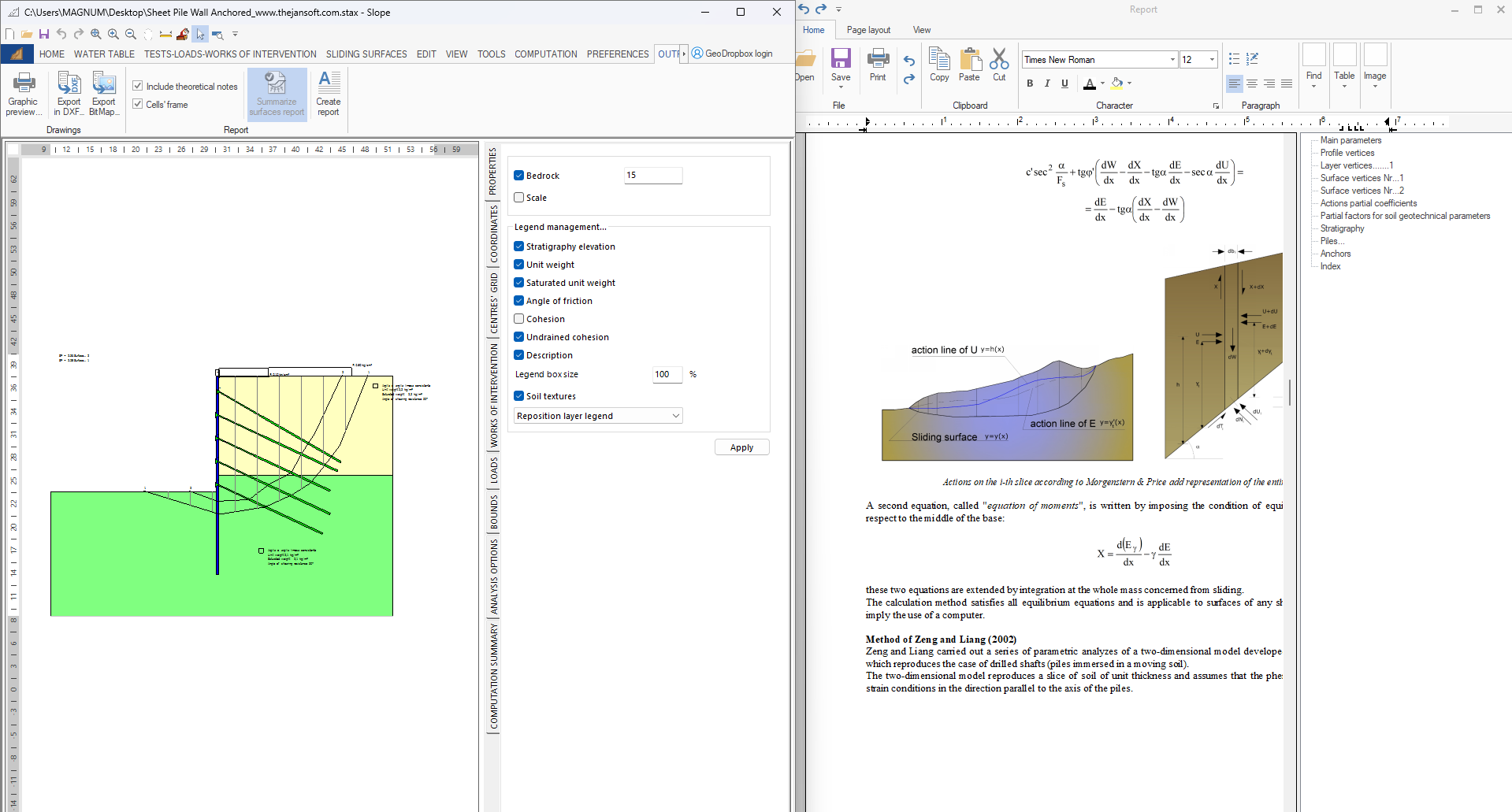Description
How to Purchase
✅ Instant Delivery (No Physical Delivery Required)
✅ Before you buy, make sure you read the Terms and Conditions
✅ If you agree to buy, you have agreed to the terms and conditions of no refunds if the reason is as described Terms and Conditions
✅ Geostru Slope 2025
✅ 1 PC license only means that it can only be used on 1 PC, the license cannot be transferred to another PC.
✅ The license file will work on the PC where is activated
✅ Active Period: Lifetime (can reinstall), Warranty 1 Years
✅ Support: Windows 10, 11
✅ Update Application: No
✅ Install Instructions: Available (video/text)
✅ It should be noted, buying = understanding product use
Note:Files & Prices may increase or decrease at any time
Slope is an advanced software for analyzing the stability of soil and rock slopes under both static and seismic conditions, utilizing well-established limit equilibrium methods such as Fellenius, Bishop, Janbu, Bell, Sarma, Spencer, Morgenstern & Price, Zeng Liang, as well as the Discrete Element Method (DEM).
Unlike traditional approaches, Slope integrates the discrete element method for both circular and non-circular slip surfaces, allowing for a more detailed assessment of failure mechanisms, progressive collapse analysis, and the application of various force-deformation models.
The software enables the modeling of geotechnical reinforcements, including piles, gravity and reinforced concrete retaining walls, nettings, geofabrics, anchors, and terracing. Additionally, it supports the definition of distributed and point loads, ensuring a comprehensive and reliable analysis for geotechnical design.
SLOPE STABILITY
SUPPORTED COMPUTATION STANDARDS
Verification analysis can be performed by employing:
-
- EN 1997-1 Eurocode 7: Geotechnical design – Part 1;
- EN 1997-2 Eurocode 7 – Geotechnical design – Part 2;
- EN 1998-1 Eurocode 8: Design of structures for earthquake resistance – Part 1: General rules, seismic actions and rules for buildings;
- EN 1998-5 Eurocode 8: Design of structures for earthquake resistance Part 5: Foundations, retaining structures and geotechnical aspects;
- GP 129-2014: SR EN 1997-1 (RO): A1+M1+R1 [GEO/STR], A2+M2+R3 [GEO];
- AASHTO LRFD Bridge Design Specifications;
- Various European and South American standards.
DATA INPUT
-
- Graphic input with mouse;
- Input from EXCEL files;
- Input from DXF files;
- Tabular numerical input;
- The input of topographic profile generated by TRISPACE, GEOSTRU MAPS, BING MAPS or GOOGLE MAPS;
- Import of raster images (JPG, BMP) with full-scale calibration;
- Input from ASCII files;
- Import of 3D models, shape file, srtm file, TXT and others and automatic generation of the sections to be analyzed;
- Import of static and dynamic soil penetration tests and generation of geotechnical section.
EMBANKMENT LOAD TYPES
-
- Point loads (inclined);
- Longitudinal loads.
REINFORCEMENTS AND INTERVENTION WORKS
-
- Retaining walls;
- Single piles, Sheet pile walls or Bulkheads;
- For piles, the structural sizing of the pile at the ultimate limit state is provided;
- Stabilization method: Broms limit load with automatic computation of the breaking moment of the section, Shear strength method, Zeng Liang’s method;
- Gabions;
- Active and passive anchors;
- Step terracing;
- Reinforced earth: bars, strips and geotextile sheets;
- Geogrids database that the user can modify;
- Drained trenches;
- The input of generic works;
- Integrated template for the automatic generation of Wind turbines and telephone towers;
- Nailed reinforcement implementation using the Soil Nailing technique;
- Naturalistic engineering works such as double-row wooden piling
COMPUTATION METHODS
-
- FELLENIUS (1936);
- BISHOP (1955);
- JANBU (1956);
- MORGENSTERN and PRICE (1965);
- SPENCER (1967);
- BELL (1968);
- SARMA (1973);
- D.E.M. (1992);
- ZENG LIANG (1995);
- Back Analysis;
- Isotropic analysis;
- Rock slope analysis with Hoek and Bray.
NEUTRAL PRESSURES INCREMENT IN THE SEISMIC FIELD
In the case of seismic, the increment of the neutral pressures produced by the deformations induced by the seismic waves is estimated. The formulas used are Matsui et al., 1980; Seed & Booker, 1997; Matasovic,1993. All the parameters necessary for the estimate, such as Arias index, Trifunac duration, etc., are calculated automatically by the programme upon integration of the design accelerogram.
COMPUTATION OPTIONS
-
- Recalculate function to evaluate the safety factor of a specific surface with centre X0, Y0 and radius R;
- Identification of the critical slide surface through automatic calculation;
- Computation of safety factor for surfaces which pass through two given points and are tangential to a straight line whose gradient varies automatically;
- Automatic computation of safety factor for surfaces that are tangential to a straight-line vector;
- Computation of safety factor for surfaces which pass through either three, or one given point;
- Differentiation between flexible and rigid retaining structures;
- Stability analysis of submerged slopes (e.g. hillside lakes);
- Analysis of irregular surfaces;
- Presence of seismicity and aquifers;
- Stratified terrains and relative pore pressures;
- Anisotropic Analysis;
- Dynamic analysis Newmark.
GRAPHIC OPTIONS
-
- Display of the safety factor isolines;
- Coloured display of all sliding surfaces divided by safety factor (to each colour are assigned the safety factors in a fixed interval);
- Selection of the surfaces to be printed;
- Options <Delete mesh>, <Move mesh> and numerical assignment of the centeres’ mesh;
- Option <Translate groundwater>, which allows to raise or lower the water table (handy command for the sensitivity of the Fs when the groundwater level varies);
- Layer filling with textures or colours (the user can define the textures);
- Graphical and numerical input for non-circular sliding surfaces;
- Tools for inserting text, lines and polygons on the graphic sheet.
ADDITIONAL FEATURES
Dynamic Analysis: Newmark’s method was used to analyze slope stability under seismic conditions for direct integration and modal superposition (1965). It allows the computation of permanent displacements of landslide mass by integrating the relative acceleration. It is also possible to generate the artificial accelerograms or import accelerograms from SIMQKE and Sabetta F., Pugliese A.: Estimation of Response Spectra and Simulation of Non-stationary Earthquake Ground Motions.
Slope 3D: Generation of digital 3D models from GIS, DXF or Text files. Import of files from SRTM (SRTM is a software created by GEOSTRU, included in the GEOAPP free suite, which allows the generation of a 3D model by simply selecting an area on Google Maps) of from GeoStru Maps, a free app for Geostru users. The sections to be analyzed with Slope are automatically created dynamically by moving on the 3D model.
DEM – Discrete Element Method: Advanced numerical method for analyzing slope stability in static and dynamic conditions. A very sophisticated model of computation of linear and nonlinear analysis based on the behaviour of the ductile or fragile soil.
M.R.E. (Mechanically reinforced earth): Design and verification of reinforced soil retaining structures. Performed validation at a pullout and break for bar or strip reinforcements and geosynthetics, local stability (Tieback), global stability (Compound), sliding verifications of a rigid body, limit load, and overturning. Provided standards: NTC2008, GRI (Geosynthetic Research Institute), BS8006/1995 (Code of practice for strengthened/reinforced soils and other fills), FHWA (Federal Highway Administration).
Geotechnical Section: Module for the realization of geotechnical sections, the user can manage static and dynamic soil penetration tests and make correlations between surveys.



Reviews
There are no reviews yet